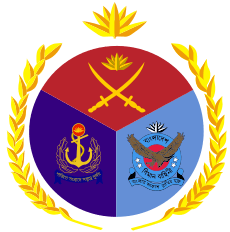East Bengal Regiment
| The East Bengal Regiment | |
|---|---|
 Cap badge of the East Bengal Regiment | |
| Active | 15 February 1948 – present |
| Country | Bangladesh |
| Branch | Army |
| Type | Infantry |
| Garrison/HQ | Chittagong |
| Nickname(s) | The Tigers |
| Motto(s) | Grace, Strength, Speed |
| Colours | Colour of coagulated blood (BCC 37) |
| March | Chal Chal Chal |
| Mascot(s) | Royal Bengal tiger |
| Anniversaries | 15 February |
| Engagements | Battle of Chawinda, Indo-Pakistani War of 1965, Bangladesh Liberation War |
The East Bengal Regiment (Bengali: ইস্ট বেঙ্গল রেজিমেন্ট) is an infantry regiment of the Bangladesh Army. It is the largest military formation of Bangladesh Army.[1]
History
The East Bengal Regiment was formed on 15 February 1948 following Pakistan's independence and transition from post British rule. The infantry of the new Pakistan Army was made up exclusively of men from the western part of the country. It was consequently necessary to raise a regiment in the east. Two companies of Bengali pioneers from the Bihar Regiment were regimented into the 1st Battalion under Lieutenant Colonel VJ Patterson as Commanding Officer (C.O.) and Major Abdul Waheed Choudhury as Officer Commanding (O.C.) Training Coy. Captain Sami Ullah Khan and Captain Abdul Gani in the lead of two Pioneer Companies (1256 and 1407). Between 1948 and 1965, a total of eight battalions were raised.[2] The East Bengal Regiment was primarily composed of Bengali men from East Pakistan.[3]
1965 Indo-Pakistani War
At the end of the Indo-Pakistani War in 1965, a new battalion called the Lucky Tigers of the 6th Bengal was created. The creation of the battalion was not finished until 1966.[4] The East Bengal regiment soldiers defended Lahore, West Pakistan during the war.[5]
History of EBR in the Bangladesh War of Independence
In March 1971, in response to a crackdown on local populace in East Pakistan, the five battalions of the East Bengal Regiment, namely 8th EBR revolted, declared independence and actively organized and initiated the Bangladesh War of Independence . The East Bengal Regiment formed the core of the independence struggle forces, which became known as the Bangladesh Forces. The structure and formation of the Bangladesh Forces during the Independence War of 1971 was determined at the Sector Commander's Conference that was held from 11 July to 17 July 1971.[6]
Colonel M.A.G. Osmani(promoted to General(post independence) was Commander-in-Chief of all Bangladesh Forces. Lieutenant Colonel M A Rab was appointed as Chief of Army Staff and Squadron Leader M. Hamidullah Khan was appointed Bangladesh Military Representative to coordinate Guerilla Training at the largest training camp of the war effort at Chakulia, Bihar. The decision of the formation of three separate brigades were formed with East Bengal Regiments.[6] The East Bengal Regiments that participated in the war were as follows:
Z Force, under Major Ziaur Rahman, consisted of 1st, 3rd and 8th East Bengal Regiment. These regiments were formed during the war at Teldhala of Tura, Meghalaya, in 1971 by Major Ziaur Rahman. These three regiments principally constituted Sector 11, later commanded by for a brief stint Major Abu Taher, and subsequently by Squadron Leader M. Hamidullah Khan.
K Force, commanded by Major Khaled Mosharraf was created with 4, 9 and 10 East Bengal.
S Force, under Major K M Shafiullah, was created in October 1971 and consisted of 2 and 11 East Bengal. Further units were raised to replace those that remained stranded in West Pakistan. Following the foundation of Bangladesh, these units formed the core of the new army. However, the 7th Battalion was incorporated as 44th Battalion, Frontier Force Regiment in the Pakistan Army, which led to the raising of the 10th Battalion in 1971.
Today, The East Bengal Regiment is made up of around 70 battalions, and it plays a key role in safeguarding the sovereignty of Bangladesh through its traditional role as an infantry force. It is the 2nd largest regiment in the world. In 2000 Bangladesh Government on the recommendation from Army Headquarters formed Bangladesh Infantry Regiment out of some of the units of East Bengal Regiment to start with, and currently the key fighting element of the Army exceeds seventy strong regiments.
Role
The East Bengal Regiment is the largest formation of the Bangladesh Army, with battalions in each of the nation's twenty five infantry brigades. Its role is to engage and defeat an enemy in frontal combat, within a traditional infantry combat scenario. The regiment also aids the civilian government when called on and contributes regularly to Bangladesh's peacekeeping commitments overseas. Bangladesh is among the countries contributing troops to the United Nations.[7]
See also
References
- ↑ "Flag distribution parade of 57 EBR held | Dhaka Tribune". www.dhakatribune.com. Retrieved 2017-07-22.
- ↑ "Maj Abdul Gani". The Daily Star. 11 November 2014. Retrieved 6 October 2016.
- ↑ "The 1965 War: A view from the east". www.rediff.com. Retrieved 2017-12-13.
- ↑ Sein, Mange Kyaw (20 May 2011). "Remembering a Tiger's Last Journey". Star Weekend Magazine. The Daily Star. Retrieved 5 October 2016.
- ↑ "1965 Indo-Pak War: Busting the myth". The Daily Star. 2014-09-08. Retrieved 2017-12-13.
- 1 2 "War of Liberation, The - Banglapedia". en.banglapedia.org. Retrieved 2017-12-13.
- ↑ As of Dec 2008, Bangladesh was ranked second behind Pakistan and ahead of India in terms of numbers of troops deployed on UNPKOS. See official UN figures, available at: http://www.un.org/Depts/dpko/dpko/contributors/2008/dec08_2.pdf
Further reading
- Makieg, Douglas C. (1989). "National Security". In Heitzman, James; Worden, Robert. Bangladesh: A Country Study. Washington, D.C.: Federal Research Division, Library of Congress. pp. 208–209.
- Gill, John H. (2003). An Atlas of the 1971 India - Pakistan War: The Creation of Bangladesh (PDF). Washington D.C.: National Defense University, Near East South Asia Center for Strategic Studies. p. 20–. OCLC 53906774.
- Cohen, Stephen P. (2016). The South Asia Papers. Brookings Institution Press. p. 206. ISBN 978-0-8157-2841-2 – via Project MUSE. (Subscription required (help)).
